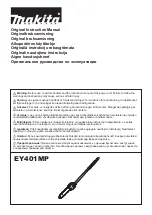
15
E N G L I S H •
User's Manual
2. Inspect the tool carefully to make sure that no
breakage or damage occurred during shipping.
3. Do not discard the packing material until you
have carefully inspected and satisfactorily oper-
ated the tool.
4. If any parts are damaged or missing, return
the product for replacement.
WARNING: If any parts are broken or miss-
ing, DO NOT attempt to plug in the power cord
or operate the saw until the broken or missing
parts are replaced. Failure to do so could result
in possibly serious injury.
WARNING: Do not attempt to modify this
saw or create accessories not recommended for
use with this saw. Any such alteration or modifi-
cation is misuse and could result in a hazardous
condition leading to possibly serious injury.
WARNING: To prevent accidental starting
that could cause serious personal injury, always
disconnect the tool from the power source
when assembling parts.
OPERATION INSTRUCTIONS
WARNING: The maximum blade capacity of
your saw is 7-1/4 inches. Any blade larger than
7-1/4 inch will come in contact with the blade
guards. Never use a blade that is so thick that it
prevents the outer blade washer from engaging
with the flat side of the spindle. Blades that are
too large or too thick can result in an accident
causing serious injury.
SAW BLADES
All saw blades need to be kept clean, sharp,
and properly set in order to cut efficiently. Us-
ing a dull blade places a heavy load on the saw
and increases the danger of kickback. Keep ex-
tra blades on hand, so sharp blades are always
available.
Gum and wood pitch that have hardened on the
blade will slow the saw. Use gum and pitch re-
mover, hot water, or kerosene to remove these
substances. Do not use gasoline.
BLADE GUARD SYSTEM
The lower blade guard is there for your protec-
tion and safety. It should never be altered for
any reason. If the lower blade guard becomes
damaged or begins to return slowly or slug-
gishly, do not operate your saw until the dam-
aged part has been repaired or replaced. Always
leave the guard in its correct operating position
when using the saw.
CAUTION: Never use the saw when the
lower blade guard is not operating properly.
The lower blade guard should be checked for
correct operation before each use. If you drop
your saw, check the lower blade guard and
bumper for damage at all depth settings before
using.
NOTE: The lower blade guard is operating prop-
erly when it moves freely and then readily re-
turns to the closed position. If, for any reason,
your lower blade guard and bumper do not
close freely, take the saw to your nearest Service
Center for service before using it.
KICKBACK
KICKBACK CAUSES
• Kickback is a sudden reaction to a pinched,
bound, or misaligned saw blade, which can
cause the saw to lift up and out of the work-
piece and toward the operator.
• When the blade is pinched or bound tightly
by the kerf closing down, the blade stalls and
the motor reaction drives the unit rapidly back
towards the operator.
• If the blade becomes twisted or misaligned in
the cut, the teeth at the rear edge of the blade
can dig into the top surface of the wood.
This causes the blade to climb out of the kerf
and jump back towards the operator.
• Sawing into knots or nails in the workpiece
can cause kickback.
• Sawing into wet or warped lumber can cause
kickback.
• Forcing a cut, or not supporting the workpiece
correctly can cause kickback.
• Kickback can result from tool misuse and/or in-
correct operating procedures or conditions.
HOW TO PREVENT KICKBACK
DANGER: Always release the trigger switch
immediately if the blade binds or the saw stalls.
Kickback could cause you to lose control of the
saw. Loss of control can lead to serious injury.
Lower Blade Guard level
is in UP position when
making a cut.
Lower Blade Guard
retracts automatically
when cut is being
made.
1/4” or less of the Blade is
exposed on the underside
of the workpiece.






































